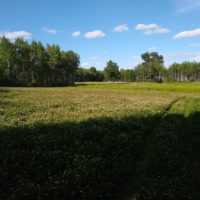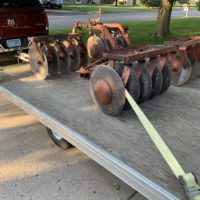You’re on the right track. The biggest workload reducer is to get good perennial plots established. Then your yearly maintenance is just down to spraying and mowing if you choose.
Attached is a picture of my north plot’s Mega Clover Plus area. This clover stand is 3 years old almost exactly, and it looks terrific. This picture was taken last week just before I mowed.
I’m not a believer in what I call “throw and no-grow”. Results are variable, and yes, some make it work, but to me it looks like 80% of the work for 50% of the results compared to working the soil up properly.
I never till as in roto-tilling, I only use the disc on annual plots. 2 passes with an aggressive, heavy disc is enough to prepare any plot for planting.
I have rock on my property and plenty of it, so a tiller is not an option. But even if I didn’t, I would not roto-till because it takes too long. It’s a very, very slow operation even in good soil. For most food plotters I think the disc is the way to go.
Tillage is probably the toughest operation to find the equipment that works for your property. Too small of equipment and it takes forever and smaller, lighter equipment is easy to over-stress and break, so sizing right is important.
But bigger, heavier equipment while being more effective and time-efficient has downsides as well. Heavy iron can be hard to work on. I just replaced a broken disc on my 8-foot disc and it required some serious wrangling. This would be easy if I had a full shop at the property, but I don’t and most of the food plotters I know are in the same boat.
There isn’t really a magic formula. Just down to finding out what works for you.
You might also find time savings elsewhere. I put a bigger boom on my sprayer and also added a gas-powered water pump so I can fill water faster. Those two additions cut my plot spraying time almost in half on a per acre basis. A tremendous increase in spraying efficiency, which is my most time-consuming plotting operation because it seems like I’m always spraying.
Grouse

